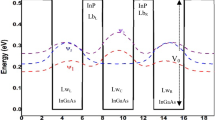Abstract
The non-magnetic material closed photonic quantum well (PQW) and magnetic material PQW structures based on the non-magnetic material open PQW are proposed. The transmission spectra and the field distributions of these three PQW structures are calculated by finite-difference time-domain method, the quantized energy states are researched, and the feasibility of enhancing spectral intensity significantly by self-structure is disclosed. It is found that the optical transmittance of the magnetic PQW is close to 1, and the energy loss is less compared to non-magnetic PQW. Compared with the closed PQW structures, the device’s volume can be reduced, the degree of free regulation of the energy band project can be increased, and more photon bound states can be obtained. The results show that the open PQW is the traveling wave well, and its capability of capturing photons is weak. However, the closed PQW and the magnetic PQW are standing wave wells. Their capabilities for capturing photons are strong, while the light field gradient of the material PQW is bigger.
Similar content being viewed by others
References
Yablonovitch E. Inhibited spontaneous emission in solid-state physics and electronics. Physical Review Letters, 1987, 58: 2059–2062
John S. Strong localization of photons in certain disordered dielectric superlattices. Physical Review Letters, 1987, 58: 2486–2489
Qiao F, Zhang C, Wan J, et al. Photonic quantum-well structures: multiple channeled filtering phenomena. Applied Physics Letters, 2000, 77(23): 3698–3700
Wang Z S, Wang L, Wu Y G, et al. Multiple channeled phenomena in heterostructures with defects mode. Applied Physics Letters, 2004, 84(10): 1629–1631
Jiang Y, Niu C, Lin D L. Resonance tunneling through photonic quantum wells. Physical Review B, 1999, 59(15): 9981–9986
Pan Y, Li Z F, Chen X S. Resonant transmission properties of photonic quantum-well structures studied by multiple-scattering theory. Journal of Infrared and Millimeter Waves, 2006, 25(1): 17–21 (in Chinese)
Yano S, Segawa Y, Bae J S, et al. Quantized state in a single quantum well structure of photonic crystals. Physical Review B, 2001, 63(15): 153316
Kono N, Koshiba M. General finite-element modeling of 2-D magnetophotonic crystal waveguides. IEEE Photonics Technology Letters, 2005, 17(7): 1432–1434
Levy M. Normal modes and birefringent magnetophotonic crystals. Journal of Applied Physics, 2006, 99: 073104
Matsuhisa Y, Ozaki R, Yoshino K, et al. High Q defect mode and laser action in one-dimensional hybrid photonic crystal containing cholesteric liquid crystal. Applied Physics Letters, 2006, 89: 101109
Zhang L Q, Han S S, Xu Z Z, et al. Research of spectrum lineshape and precise measurements of line intensity in laser plasmas. High Power Laser and Particle Beams, 1995, 7(3): 339–344 (in Chinese)
Li G L, Yu P K L. Optical intensity modulators for digital and analog applications. Journal of Lightwave Technology, 2003, 21(9): 2010–2030
Zhou S L, Zhu J, Li X C, et al. Experimental study of smoothing by spectral dispersion. Chinese Journal of Lasers, 2006, 33(3): 321–325 (in Chinese)
Song J O, Leem D S, Kwak J S, et al. Improvement of the luminous intensity of light-emitting diodes by using highly transparent Ag-indium tin oxide p-type ohmic contacts. IEEE Photonics Technology Letters, 2005, 17(2): 291–293
Yee K S. Numerical solution of initial boundary value problem involving Maxwellc’s equations in isotropic media. IEEE Transactions on Antennas and Propagation, 1966, 14(3): 302–307
Lu X D, Han P D, Quan Y J, et al. Influences of wave vector direction on energy bands and applications of two-dimensional photonic crystals. Chinese Journal of Lasers, 2006, 33(6): 770–774 (in Chinese)
Lin X B, Chen Y J, Li B J. Photonic crystal with absolute band gap in a two-dimensional quasi-honeycomb structure. Acta Optica Sinica, 2006, 26(1): 126–130 (in Chinese)
Zhang B. Absorbing boundary conditions for two-dimensional photonic crystal waveguides. Acta Physica Sinica, 2005, 54(12): 5677–5682 (in Chinese)
Author information
Authors and Affiliations
Corresponding author
Additional information
__________
Translated from Chinese Journal of Lasers, 2007, 34(5): 649–654 [译自: 中国激光]
Rights and permissions
About this article
Cite this article
Liu, J., Sun, J., Huang, D. et al. Influence of two-dimensional magnetic photonic quantum wells on resonant tunneling spectral character. Front. Optoelectron. China 1, 156–161 (2008). https://doi.org/10.1007/s12200-008-0006-4
Published:
Issue Date:
DOI: https://doi.org/10.1007/s12200-008-0006-4



